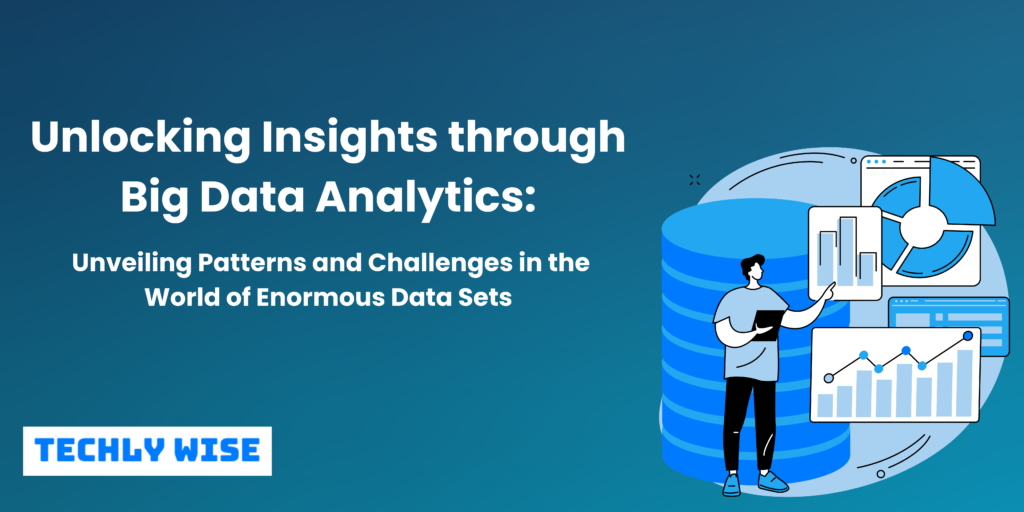
Big data analytics is the process of identifying patterns, trends, and correlations in enormous amounts of raw data to assist data-driven decision-making. These methods employ more contemporary technologies to apply well-known statistical analysis methods, such as regression and clustering, to bigger datasets.
The term “big data” has gained popularity since the early 2000s, when improvements in technology and software allowed corporations to manage enormous amounts of unstructured data. Since then, new technologies from smartphones to Amazon have added even more to the large volumes of data that organizations may now access.
Data engineers explore ways to combine the enormous volumes of complex information produced by sensors, networks, transactions, smart devices, web usage, and more; this discipline continues to develop.
Working on Big Data Analytics
To assist businesses in operationalizing their big data, big data analytics refers to the cleansing, processing, collection, and analysis of massive datasets.
- Collect Data
Every organization uniquely approaches data collection. Organizations may now collect structured and unstructured data from a range of sources, including cloud storage, mobile apps, in-store IoT sensors, and more, thanks to modern technology. For easy access by business intelligence tools and solutions, part of the data will be kept in data warehouses.
- Process Data
To get accurate results from analytical queries, data must be properly organized after it has been collected and stored, especially when the data is large and unstructured. Data processing is becoming more difficult for organizations as the amount of data available increases dramatically. Batch processing, which examines huge data items over time, is one processing choice. When there is a longer lag between the collection of data and its analysis, batch processing is beneficial.
- Clean Data
All data must be accurately prepared, and any redundant or irrelevant data must be removed or accounted for to improve data quality and produce stronger findings. Due to its ability to conceal and deceive, filthy data might produce inaccurate insights.
- Analysis of Data
Huge data must first be transformed into a form that can be used. Once they are ready, advanced analytics systems may be able to extract valuable insights from enormous amounts of data. These techniques for massive data analysis consist of:
- Using anomalies and data clusters, data mining sifts through enormous databases to find patterns and relationships.
- Predictive analytics analyses historical data from an organization to forecast the future while identifying potential dangers and opportunities.
- Deep learning layers algorithms to uncover patterns in even the most complicated and abstract data, and then mimic human learning patterns by doing so.
Big Data Analytics Technology and Tool
The field of big data analytics is too broad to be confined to a single tool or technology. The following list includes some of the key participants in big data ecosystems.
- Hadoop
Hadoop is an open-source platform that efficiently stores and analyses massive datasets on clusters of affordable technology. This platform is a must-have component of any big data operation since it is cost-free and can manage massive volumes of both structured and unstructured data.
- YARN
YARN is an acronym for “Yet Another Resource Negotiator.” It is a further part of Hadoop 2’s architecture.
- Spark
Spark is a free and open-source framework for cluster computing that combines implicit data parallelism and fault tolerance to offer a graphical programming interface for entire clusters. For quick computing, Spark can perform both batch and stream processing.
- NoSQL Database
NoSQL databases are non-relational data management systems without the need for a set structure, making them an excellent choice for large amounts of unstructured, unprocessed data. These databases, which stand for “not only SQL,” can handle different types of data models.
- MapReduce
Serving two purposes, MapReduce is a crucial part of the Hadoop platform. The first is mapping, which distributes data to different cluster nodes. The second method is reduction, which groups and condenses each node’s results to respond to a query.
- Tableau
Tableau is a comprehensive data analytics application that enables you to assess, organize, communicate with others, and share your big data insights. With Tableau, users can browse large data, perform self-service visual analysis, and easily communicate their findings with others within the organization.
Read Unlocking Datafication: Advantages & Challenges.
Importance of Big Data Analytics
Today, across all industries, big data analytics is the driving force behind everything we do online. Using Spotify as an example, you can listen to music. Each day, the company’s 96 million users generate huge quantities of data.
The cloud-based platform uses this data to automatically produce new music using a clever recommendation engine that thinks about likes, search history, shares, and other factors. The frameworks, methods, and tools developed as a result of big data analytics enable this.
The top recommendations part of Spotify, which is based on your preferences, historical usage, and other factors, is undoubtedly something you’ve noticed if you use it. It is effective to use a recommendation engine that makes use of data filtering technologies, which gather data and then filter it using algorithms.
What Spotify does is this. The data management courses offered by Simplilearn will improve your career possibilities. Keep up with trends and growth in demand as a data professional.
Uses and Examples
Here are a few instances:
- Applying analytics to comprehend consumer behavior and enhance the user experience.
- Predict future trends to help with business decision-making.
- Increasing the effectiveness of marketing campaigns by learning what works and what doesn’t.
- Improving operational effectiveness by identifying and eliminating bottlenecks.
- Quicker detection of fraud and other types of abuse
These are but a few instances; when it comes to big data analytics, the options are almost limitless. It all depends on how you want to use it to advance your company.
Lifecycle Phases of Big Data Analytics
Let’s explore how Big Data analytics functions right now:
- Step 1:
Evaluation of the business case: A business case, that outlines the rationale and objective of the analysis, is the first step in the Big Data analytics lifecycle.
- Step 2:
Data source identification: A wide range of data sources are identified here.
- Step 3:
Data filtration: To eliminate corrupt data, all of the recognized data from the previous stage is filtered here.
- Step 4:
Extraction of data: Data that is incompatible with the tool is extracted, and it is then changed into a compatible format.
- Step 5:
Aggregation of data: In this phase, data from many datasets that have the same fields are combined.
- Step 6:
Analysis of data: To extract usable information from data, analytical and statistical methods are used to assess the data.
- Step 7:
Data visualization: Big Data analysts can create visual representations of the analysis using programs like Power BI, Tableau, and QlikView.
- Step 8:
Final analytical findings: At this point, the Big Data analytics lifecycle is complete, and the analysis’s final results are made available to corporate stakeholders who will act on them.
Types of Big Data Analytics
Four categories of data analytics exist:
- Descriptive Analytics
This presents historical data in an accessible format. This facilitates the creation of reports on a company’s earnings, sales, profits, and other metrics. It also aids in gathering social media statistics.
Use Case: To maximize facility utilization across its office and lab facilities, The Dow Chemical Company examined historical data. Dow discovered underused space by using descriptive analytics. The corporation was able to save around USD 4 million yearly because of this space consolidation.
- Analytical Prediction
To predict the future, this sort of analytics examines both historical and current data. To analyze current data and forecast the future, predictive analytics uses data mining, AI, and machine learning. It operates by anticipating consumer, market, and other trends.
Use Case: PayPal decides what security measures to use to safeguard its customers from fraudulent transactions. Using predictive analytics, the business creates an algorithm that anticipates fraudulent acts using all the historical payment and user behavior data.
- Prescriptive Analytics
This form of analytics proposes a fix for a particular problem. With perspective analytics, you may employ both predictive and descriptive analytics. It frequently makes use of AI and machine learning.
Use Case: To increase an airline’s profit, prescriptive analytics can be applied. With the use of this kind of analytics, an algorithm that can automatically modify flight costs based on a variety of variables, such as weather, client demand, holiday seasons, destination, and oil prices, can be built.
- Diagnostic Analytics
To comprehend the root cause of a problem, this is done. Data recovery, data mining, and drill-down are a few examples of approaches. Organizations utilize diagnostic analytics because they offer a thorough understanding of a specific issue.
Advantages of Big Data Analytics
- Risk Management
Banco de Oro, a financial company in the Philippines, uses big data analytics to detect abnormalities and fraud. It helps the organization narrow down a list of prospective suspects or the root causes of problems.
- Organizational Decision-Making that is Faster and Better
Starbucks uses big data analytics to guide key decisions. The company, for instance, utilizes it to decide whether a particular area would be suitable for a new outlet or not. They will look at a variety of elements, such as geographic accessibility, demographics, and population.
- Enhance the client experience
Delta Air Lines uses big data analysis to enhance the customer experience. They read tweets to learn about the experiences of their clients about their delays, travels, and other issues. The airline recognizes unfavorable tweets and takes the necessary steps to put things right. By openly discussing these issues and offering solutions, the airline enhances its relationship with its customers.
Challenges of Big Data
Big data has many benefits, but it also poses many obstacles, including new privacy and security worries, business user accessibility, and selecting the best solutions for your company’s requirements. Organizations must deal with the following issues to benefit from incoming data:
- Safeguarding Data.
Concerns about privacy and security increase as data volume increases. Before utilizing big data, organizations will need to work toward compliance and set up strict data protocols.
- Choosing the Appropriate Platforms and Tools.
Big data processing and analysis technologies are always evolving. To function within their current ecosystems and meet their specific needs, organizations must locate the appropriate technology. A flexible system that can adapt to future infrastructure changes is frequently the best option.
- Maintaining High-quality Data.
Due to the overwhelming amount of data that needs to be maintained, organizations are spending more time than ever before looking for duplication, conflicts, absences, errors, and inconsistencies.
- Facilitating Access to Huge Data.
As data volume increases, collecting and analyzing it becomes more challenging. Data must be made accessible and convenient for users of all skill levels by organizations.




